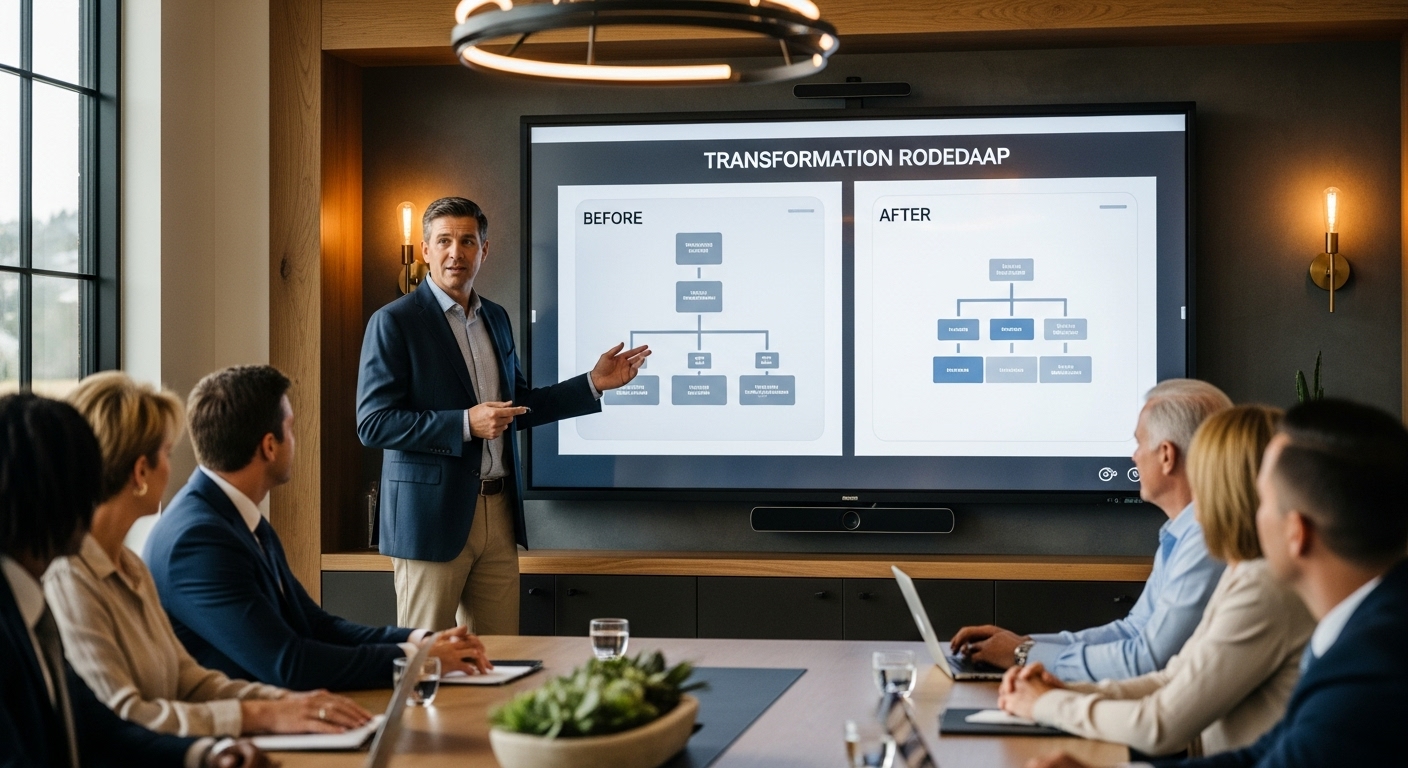August 9, 2025 by 100XBuilds Team
Change Management Framework for Construction Companies

When Toll Brothers implemented their enterprise-wide digital transformation in 2019, they faced a 47% employee resistance rate in the first quarter. By month 12, they achieved 94% adoption across all divisions and increased project delivery speed by 31%. The difference? A systematic change management approach that treated organizational transformation as strategically as they approach luxury home construction.
For luxury builders generating $5M+ annually, implementing new systems isn't just about technology—it's about orchestrating human behavior, process evolution, and cultural shifts that determine whether your investment delivers ROI or becomes another expensive lesson.
The $2.3M Cost of Failed Change Initiatives
Recent industry analysis reveals that 68% of construction companies abandon new system implementations within 18 months, with the average failed initiative costing luxury builders $2.3M in direct expenses plus opportunity costs. The primary failure point isn't technical—it's human resistance to change.

The hidden costs of change resistance include:
Project delays: Teams reverting to old processes during critical phases
Duplicate systems: Running parallel processes that drain resources
Talent exodus: Key personnel leaving during transition periods
Client impact: Service disruptions affecting luxury client experience
Competitive disadvantage: Slower adaptation while competitors advance
The Builder's Change Management Framework
Successful organizational transformation in luxury construction requires a methodology that respects the unique challenges of project-based businesses while driving systematic adoption.
Phase 1: Strategic Foundation (Weeks 1-4)
Change Vision Development
Your transformation vision must connect directly to business outcomes that matter to every stakeholder level. Instead of "implementing new software," frame it as "reducing project delivery time by 25% while maintaining our quality standards."
Stakeholder Impact Analysis
Map every role affected by the change:
Project managers: How will daily workflows shift?
Field supervisors: What new tools will they use on-site?
Administrative staff: Which processes will be automated?
Subcontractors: How will communication protocols change?
Clients: What improvements will they experience?

Resistance Prediction Modeling
Identify likely resistance sources before they emerge:
Technical resistance: Staff uncomfortable with new systems
Process resistance: Teams attached to current workflows
Cultural resistance: "We've always done it this way" mentality
Resource resistance: Concerns about time investment during busy periods
Phase 2: Coalition Building (Weeks 3-8)
Change Champion Network
Select influential team members from each department who demonstrate both technical aptitude and peer respect. These champions become your transformation ambassadors, not just trainers.
Champion selection criteria:
Peer influence: Colleagues seek their opinions
Technical comfort: Quick to adopt new tools
Communication skills: Can explain complex concepts simply
Credibility: Track record of successful project delivery
Executive Sponsorship Activation
Your leadership team must visibly champion the change through actions, not just announcements. This means using new systems in meetings, referencing transformation progress in company communications, and allocating dedicated time for change activities.
Phase 3: Capability Development (Weeks 6-16)
Competency-Based Training Design
Traditional training focuses on features. Transformation training focuses on competencies—the specific skills needed to excel in the new environment.

Training modules should address:
Core competencies: Essential skills for daily operations
Advanced capabilities: Features that drive competitive advantage
Troubleshooting protocols: Self-service problem resolution
Integration workflows: How new systems connect with existing processes
Mentorship Pairing System
Pair early adopters with team members who need additional support. This creates peer-to-peer learning that's more effective than formal training alone.
Performance Support Tools
Develop quick-reference guides, video tutorials, and decision trees that provide just-in-time assistance during real work situations.
Phase 4: Implementation Orchestration (Weeks 12-24)
Phased Rollout Strategy
Implement changes in carefully planned phases that minimize business disruption:
Pilot phase: Single project or department
Expansion phase: Additional projects with lessons learned applied
Full deployment: Organization-wide implementation
Optimization phase: Continuous improvement based on usage data
Communication Cadence
Maintain consistent communication throughout the transformation:
Weekly updates: Progress reports to all stakeholders
Monthly town halls: Open forums for questions and feedback
Quarterly reviews: Formal assessment of transformation metrics
Success story sharing: Highlighting wins and best practices

Overcoming Builder-Specific Change Challenges
Managing Seasonal Workflow Variations
Luxury builders face unique timing challenges with seasonal construction cycles. Plan major change initiatives during slower periods, but maintain momentum through busy seasons with micro-learning approaches.
Seasonal change strategies:
Winter planning: Major training and system setup during slower months
Spring preparation: Quick refreshers before busy season begins
Summer support: Just-in-time assistance during peak construction
Fall optimization: Process refinement based on busy season experience
Integrating Subcontractor Networks
Your transformation must extend beyond internal teams to include key subcontractors who impact project delivery.
Subcontractor engagement tactics:
Early involvement: Include key subs in planning discussions
Simplified interfaces: Provide easy-to-use tools for external partners
Incentive alignment: Reward subs who adopt new processes quickly
Support provision: Offer training and technical assistance
Maintaining Quality Standards During Transition
Luxury clients expect consistent quality regardless of internal changes. Build quality checkpoints into your transformation process.
Quality protection measures:
Parallel processing: Run old and new systems simultaneously during critical phases
Quality audits: Increased inspection frequency during transition periods
Client communication: Proactive updates about improvements without exposing internal challenges
Escalation protocols: Clear procedures for handling transition-related issues
Measuring Transformation Success
Leading Indicators (Weeks 1-12)
Training completion rates: Percentage of staff completing required training
System login frequency: Daily active users in new systems
Support ticket volume: Questions and issues requiring assistance
Champion engagement: Activity levels of change champions
Lagging Indicators (Months 3-12)
Process efficiency gains: Time reduction in key workflows
Error rate improvements: Decreased mistakes in critical processes
Employee satisfaction: Survey results regarding new systems and processes
Client satisfaction: Feedback on service improvements
Financial impact: ROI measurement including cost savings and revenue increases

Sustaining Transformation Momentum
Continuous Improvement Culture
Transform your organization from change-resistant to change-adaptive by embedding continuous improvement into daily operations.
Improvement mechanisms:
Monthly process reviews: Regular assessment of workflow effectiveness
Innovation time: Dedicated hours for exploring process enhancements
Cross-department collaboration: Regular meetings between teams to identify optimization opportunities
Technology updates: Systematic evaluation of new tools and capabilities
Knowledge Management Systems
Capture and share lessons learned to accelerate future transformations.
Knowledge capture strategies:
Process documentation: Updated procedures reflecting new workflows
Best practice libraries: Repositories of successful approaches
Failure analysis: Honest assessment of what didn't work and why
Success story archives: Detailed case studies of transformation wins
Change Readiness Assessment
Regularly evaluate your organization's capacity for future changes.
Readiness factors:
Leadership commitment: Executive support for ongoing evolution
Team adaptability: Staff comfort with learning new approaches
System flexibility: Technology infrastructure that supports change
Cultural openness: Organization-wide acceptance of continuous improvement
The Competitive Advantage of Change Mastery
Luxury builders who master organizational transformation gain sustainable competitive advantages that compound over time. While competitors struggle with system implementations and process changes, transformation-ready organizations adapt quickly to market shifts, technology advances, and client expectations.
Transformation mastery delivers:
Faster market response: Quick adaptation to industry changes
Higher employee retention: Teams that thrive in dynamic environments
Superior client experience: Consistent service delivery despite internal changes
Operational efficiency: Streamlined processes that reduce costs and increase margins
Innovation capacity: Organizational ability to experiment and improve continuously
The luxury construction market rewards builders who can deliver exceptional results while continuously evolving their capabilities. Change management isn't just about implementing new systems—it's about building an organization that thrives on transformation and uses change as a competitive weapon.
Ready to transform your organization's approach to change? Our change management specialists have guided 50+ luxury builders through successful transformations, with an average ROI of 340% within 18 months. Schedule your transformation assessment today and discover how systematic change management can accelerate your growth while strengthening your competitive position.
